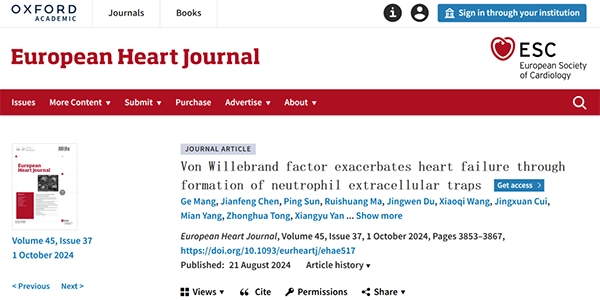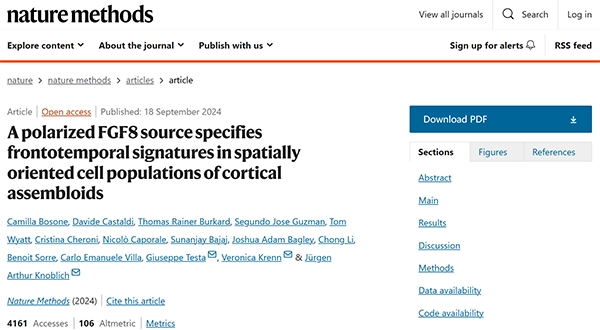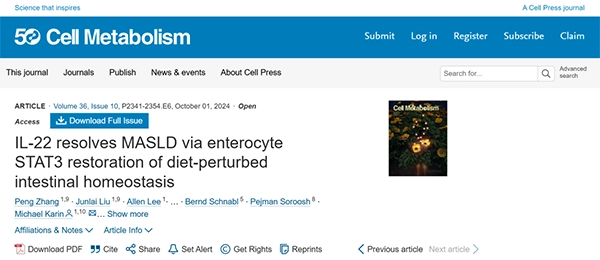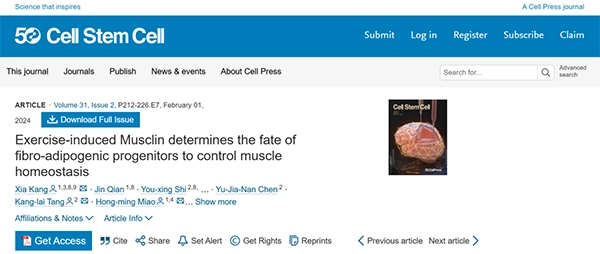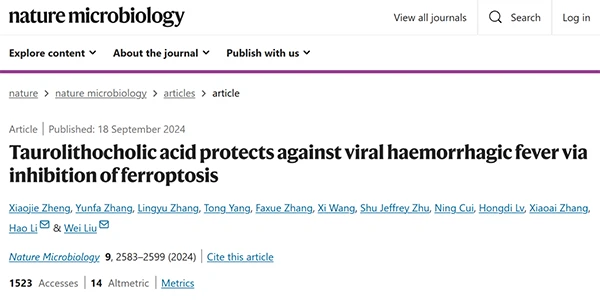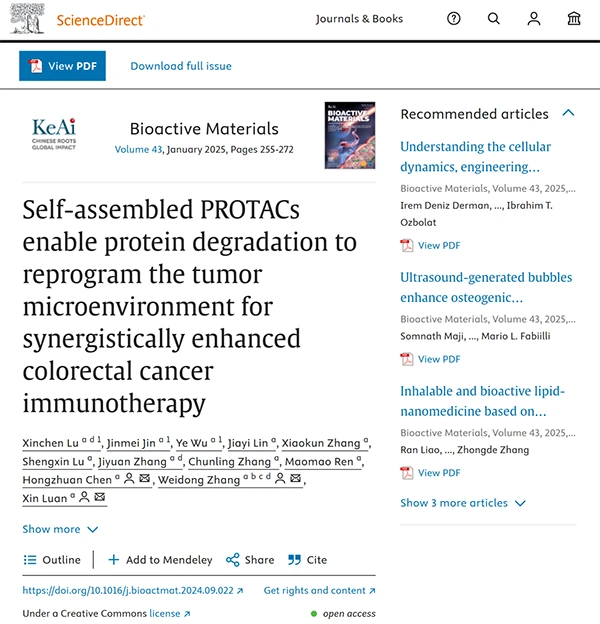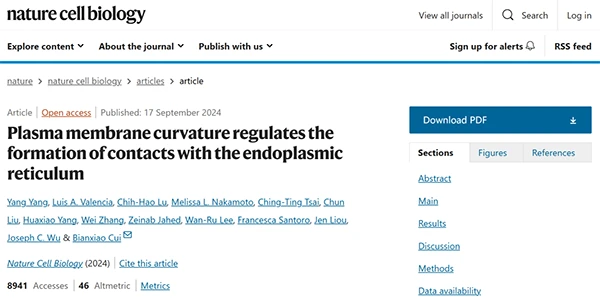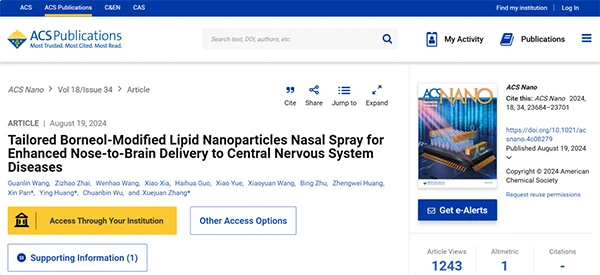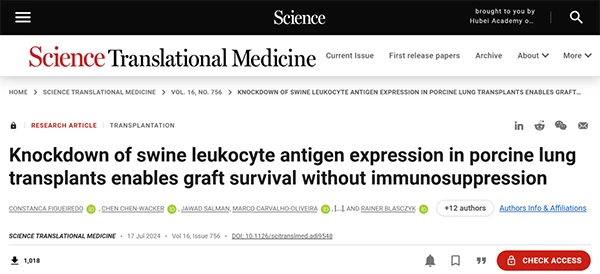Thank you for your continued support of CUSABIO! In October of 2024, articles related to CUSABIO products were published in excess of 240, with a cumulative impact factor exceeding 1200. The total number of articles has reached 23,800. Thank you for choosing CUSABIO research products during your scientific research journey. Thank you again for your trust and support. We will continue to work hard to provide you with better products and services. Now let's share our wonderful research results.
CUSABIO Monthly Citations Review
01 Von Willebrand factor exacerbates heart failure through formation of neutrophil extracellular traps
Impact Factor: 37.6
Journal Name: European Heart Journal
CUSABIO Citation Product:
Mouse ADAM metallopeptidase with thrombospondin type 1 motif, 13 (ADAMTS13) ELISA kit; CSB-EL001301MO
Research Highlights:
This article investigates the mechanism by which von Willebrand factor (VWF) exacerbates heart failure through the formation of neutrophil extracellular traps (NETs). The study found that NET levels are elevated in heart failure patients and mouse models, correlating with deteriorating cardiac function. Mechanistically, NETs impair mitochondrial function in cardiomyocytes by suppressing PGC-1α through the NE-TLR4 pathway. The study also discovered that VWF/ADAMTS13 regulates NET formation via SLC44A2, and the heart failure drug sacubitril/valsartan (LCZ696) can enhance the cardioprotective effects of blocking the VWF-SLC44A2-NET axis. This research establishes the role of the VWF-SLC44A2-NET axis in regulating mitochondrial homeostasis and function, leading to cardiac apoptosis and contributing to heart failure pathogenesis, offering potential new therapeutic targets for heart failure treatment.
02 A polarized FGF8 source specifies frontotemporal signatures in spatially oriented cell populations of cortical assembloids
Impact Factor: 36.1
Journal Name: Nature Methods
CUSABIO Citation Product:
Human Fibroblast Growth Factor 8(FGF8) ELISA Kit; CSB-E15861h
Research Highlights:
This article describes how to engineer human cortical assembloids (polCAs) to model the regionalization of cortical development in the brain. Researchers achieved controlled modulation of FGF8 signaling along the longitudinal axis of the assembloids by fusing an organizer-like structure expressing fibroblast growth factor 8 (FGF8) with an elongated organoid. These polarized cortical assembloids exhibit position-dependent transcriptional programs that partially match in vivo rostrocaudal gene expression patterns and are lost upon mutation in the FGFR3 gene associated with temporal lobe malformations and intellectual disabilities. By producing spatially oriented cell populations with signatures related to frontal and temporal area identity within individual assembloids, this model recapitulates early transcriptional divergence and enables the study of cortical area-relevant alterations underlying human disorders.
03 IL-22 resolves MASLD via enterocyte STAT3 restoration of diet-perturbed intestinal homeostasis
Impact Factor: 27.7
Journal Name: Cell Metabolism
CUSABIO Citation Product:
Mouse Lipopolysaccharides(LPS) ELISA Kit; CSB-E13066m
Research Highlights:
This article investigates how taurolithocholic acid (TLCA) protects against viral hemorrhagic fever by inhibiting ferroptosis. The study found that high levels of TLCA are associated with reduced fatality rates and suppressed viremia in patients infected with severe fever with thrombocytopenia syndrome virus (SFTSV). TLCA inhibits SFTSV replication in vitro and mitigates SFTSV-induced ferroptosis by upregulating fatty acid desaturase 2 (FADS2) via the TGR5-PI3K/AKT-SREBP2 axis. Additionally, TLCA treatment protects mice from lethal SFTSV infection.
04 Exercise-induced Musclin determines the fate of fibro-adipogenic progenitors to control muscle homeostasis
Impact Factor: 23.9
Journal Name: Cell stem cell
CUSABIO Citation Product:
Mouse Osteocrin(OSTN) ELISA kit; CSB-EL017269MO
Research Highlights:
This article investigates how exercise-induced Musclin controls the fate of fibro-adipogenic progenitors (FAPs) to maintain muscle homeostasis. The study found that Musclin, present in muscles after exercise, can reduce the number of FAPs, decrease collagen deposition and adipose formation, and upregulate the expression of FILIP1L through the AKT/FoxO3a signaling pathway, promoting apoptosis in FAPs. Additionally, Musclin facilitates the clearance of apoptotic FAPs by macrophages by downregulating CD47 expression, which aids in muscle tissue reconstruction and homeostasis. These findings reveal the long-term effects of exercise on muscle repair and regeneration and suggest potential therapeutic strategies for treating muscle atrophy or acute muscle injury.
05 Notch1 regulates hepatic thrombopoietin production
Impact Factor: 21
Journal Name: Blood
CUSABIO Citation Product:
Mouse Thyroid-Peroxidase,TPO ELISA Kit; CSB-E08353m
Research Highlights:
This article uncovers a novel role of the Notch1 signaling pathway in the liver production of thrombopoietin (TPO). The study found that hepatocyte-specific Notch1 deficiency impairs hepatic TPO production, leading to reduced platelet numbers. The research also revealed that desialylated platelets activate Notch1 signaling in hepatocytes, increasing HES5 expression and promoting JAK2/STAT3 phosphorylation, which regulates TPO production. Additionally, the study discovered a physical association between hepatocyte Ashwell-Morell receptor (AMR) and Notch1, which is involved in the activation of Notch1 signaling and TPO production. These findings not only clarify the role of Notch1 in regulating hepatic TPO production but also may provide new targets for modulating TPO levels.
06 Taurolithocholic acid protects against viral haemorrhagic fever via inhibition of ferroptosis
Impact Factor: 20.5
Journal Name: Nature Microbiology
CUSABIO Citation Product:
Human hepcidin(Hepc) ELISA Kit; CSB-E13062h
Research Highlights:
This article reveals that taurolithocholic acid (TLCA) protects against viral hemorrhagic fever by inhibiting ferroptosis.
07 Self-assembled PROTACs enable protein degradation to reprogram the tumor microenvironment for synergistically enhanced colorectal cancer immunotherapy
Impact Factor: 18
Journal Name: Bioactive Materials
CUSABIO Citation Product:
Recombinant Human Catenin beta-1 (CTNNB1); CSB-EP006169HUa0
Research Highlights:
This article presents self-assembled PROTACs (NP-PROTACs) that can effectively degrade β-catenin and STAT3 proteins in colorectal cancer, reprogramming the tumor microenvironment to enhance the efficacy of immunotherapy.
08 Plasma membrane curvature regulates the formation of contacts with the endoplasmic reticulum
Impact Factor: 17.3
Journal Name: Nature Cell Biology
CUSABIO Citation Product:
EHD2 Antibody; CSB-PA873710LA01HU
CAV2 Antibody; CSB-PA004572LA01HU
EHD1 Antibody; CSB-PA884470LA01HU
Research Highlights:
This article investigates how plasma membrane (PM) curvature regulates the formation of contact sites between the endoplasmic reticulum (ER) and the PM. The research team discovered that PM curvature plays a crucial role in locally inducing the formation of ER-PM contact sites in cardiomyocytes, which is essential for calcium regulation and lipid homeostasis.
09 Tailored Borneol-Modified Lipid Nanoparticles Nasal Spray for Enhanced Nose-to-Brain Delivery to Central Nervous System Diseases
Impact Factor: 15.8
Journal Name: ACS Nano
CUSABIO Citation Product:
Rat Interleukin 6,IL-6 ELISA KIT; CSB-E04640r
Rat calcitonin gene related peptide,CGRP ELISA Kit; CSB-E08211r
Research Highlights:
This article introduces a novel nasal spray—borneol-modified lipid nanoparticles nasal spray (BLNP-NS)—that aims to enhance drug delivery from the nose to the brain for the treatment of central nervous system diseases. The research team discovered that by adjusting the viscosity of the dispersion medium, drug deposition in the nasal cavity, especially in the olfactory region, can be significantly improved, thereby enhancing nose-to-brain drug delivery. BLNP-NS facilitates the opening of tight junction channels through borneol modification, accelerating drug absorption in the nasal mucosa, and improving drug brain targeting efficiency. It also shows promising effects in a chronic migraine rat model. This study not only enhances the nose-to-brain delivery efficiency of nasal sprays but also provides new insights for the treatment of central nervous system diseases.
10 Knockdown of swine leukocyte antigen expression in porcine lung transplants enables graft survival without immunosuppression
Impact Factor: 15.8
Journal Name: Science translational medicine
CUSABIO Citation Product:
Pig Immunoglobulin G(IgG) ELISA Kit; CSB-E06804p
Research Highlights:
This article reports a groundbreaking study where the expression of the major histocompatibility complex (MHC) molecules in pig lung transplants, known as swine leukocyte antigens (SLA), was genetically engineered to be down-regulated, enabling transplant survival without the need for immunosuppression. The research team used lentiviral transduction technology to silence mRNAs encoding β2-microglobulin and class II transactivator during ex vivo lung perfusion, thereby reducing SLA expression. In the experiment, all transplanted lungs in the control group (lungs with unmodified SLA expression) were rejected within 3 months, whereas five out of seven pigs in the treatment group maintained graft survival without immunosuppression during a 2-year monitoring period. This discovery offers a potential new strategy in the field of transplant medicine, which could relieve transplant recipients of the long-term burden of immunosuppression, improving graft survival rates and quality of life.
23000+ Published Papers!
CUSABIO team. CUSABIO Monthly Citations Review: October 2024, Over 240 Citations with an Impact Factor Exceeding 1200, Totaling 23,800 Articles!. https://www.cusabio.com/c-21196.html


